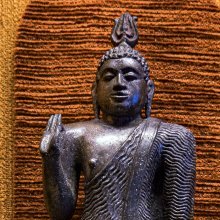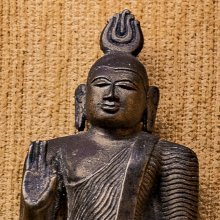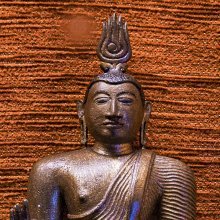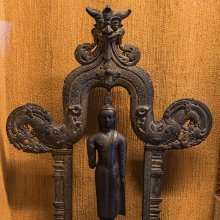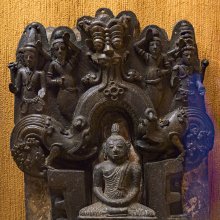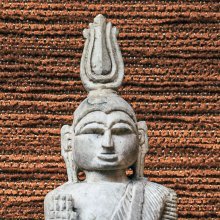Pratima, Pratimā: 35 definitions
Introduction:
Pratima means something in Buddhism, Pali, Hinduism, Sanskrit, Jainism, Prakrit, the history of ancient India, Marathi, Hindi. If you want to know the exact meaning, history, etymology or English translation of this term then check out the descriptions on this page. Add your comment or reference to a book if you want to contribute to this summary article.
Images (photo gallery)
(+13 more images available)
In Hinduism
Pancaratra (worship of Nārāyaṇa)
Source: SriMatham: Vaiṣṇava Iconology based on Pañcarātra Āgamapratima–Sanskrit term meaning 'resemblance', 'similitude' or 'representation' and used in hindu iconology (e.g. the Āgamas).
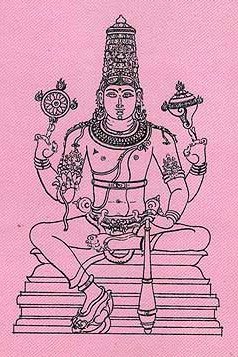
Pancaratra (पाञ्चरात्र, pāñcarātra) represents a tradition of Hinduism where Narayana is revered and worshipped. Closeley related to Vaishnavism, the Pancaratra literature includes various Agamas and tantras incorporating many Vaishnava philosophies.
Shilpashastra (iconography)
Source: Wisdom Library: Śilpa-śāstraPratima (प्रतिम) is a Sanskrit word translating to “resemblance”, “similtude” or “representation”. It is used throughout texts and practice of Hindu iconology.
Source: McGill: The architectural theory of the Mānasāra (iconography)Pratimā (प्रतिमा).—In Mānasāra chapter LXIV titled pratimāvidhanam, “Composition of Images (pratimā)”, twelve options for obtaining the height of secondary images are given. They are:
- from height of linga (in case of Śaiva temples);
- from height of the main image of Viṣṇu (in Vaiṣṇava temples);
- from half-breadth of the adytum of the temple;
- from breadth of the temple;
- from door;
- from base of the temple;
- from main pillar;
- according to hasta, cubit;
- according to tāla, “span”;
- from body of the yajamāna, “patron” or “client”;
- from one division of the height of liṅga or image;
- according to digit.
These lists of options display an “instrumental” nature, primarily as a means of procuring the height of the image.
Source: Shodhganga: The significance of the mūla-beras (śilpa)Pratimā (प्रतिमा) refers to a “representation” of the supreme being.—The term “image” finds its close parallel in Sanskrit words like pratikṛti, pratimā, bimba, and so on. In Sanskrit, pratimā means tulyata or equality, rūpa or form, pratibimba or reflection as in a mirror. The word bimba means imitation and it is very frequently used in the sense of the images of divinities. The Hindus have believed from very early times that pratimā is representation, a resemblance, or a form of the Supreme Being; standing in the place of God. Pratimā tends to bring the worshipper near the worshipped. The word “idol” is often used in a derogatory sense, signifying “false god”. Therefore, the word “image” is a near approximation to the sense of pratimā. An image made of metal is called bimba, and one that is carved by hand is known as pratimā. In general, all the icons are called paḍima.
Source: Shodhganga: Elements of Art and Architecture in the Trtiyakhanda of the Visnudharmottarapurana (shilpa)Pratimā (प्रतिमा) refers to one of the synonyms for “image” or “idol”, according to the Viṣṇudharmottarapurāṇa, an ancient Sanskrit text which (being encyclopedic in nature) deals with a variety of cultural topics such as arts, architecture, music, grammar and astronomy.—The Śilpaśāstras viz., the Bṛhatsaṃhitā, Mānasāra, Śilparatna, Devatāmurtiprakaraṇa etc. have the discussion on Iconography. [...] In Sanskrit, different words like mūrti, pratimā, devatārūpa etc. are used to denote image or idol. In the Viṣṇudharmottarapurāṇa the word pratimā is used to denote image and it gives a detail explanation on the characteristics of images of various gods and goddesses in the chapters from 44 to 85.
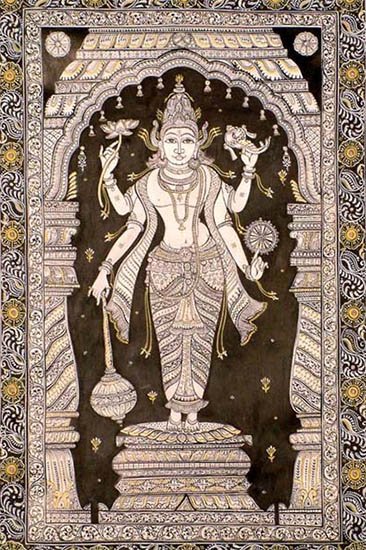
Shilpashastra (शिल्पशास्त्र, śilpaśāstra) represents the ancient Indian science (shastra) of creative arts (shilpa) such as sculpture, iconography and painting. Closely related to Vastushastra (architecture), they often share the same literature.
Dharmashastra (religious law)
Source: Wisdom Library: Dharma-śāstraPratimā (प्रतिमा) refers to “images of gods”. The word is used throughout Dharmaśāstra literature such as the Manusmṛti. (See the Manubhāṣya, verse 9.285)
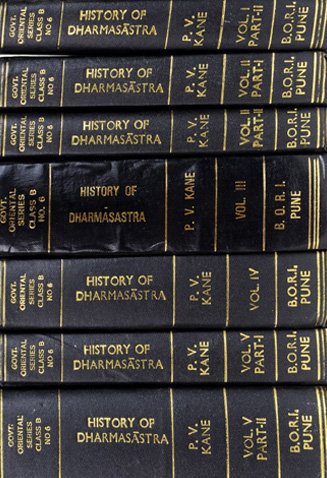
Dharmashastra (धर्मशास्त्र, dharmaśāstra) contains the instructions (shastra) regarding religious conduct of livelihood (dharma), ceremonies, jurisprudence (study of law) and more. It is categorized as smriti, an important and authoritative selection of books dealing with the Hindu lifestyle.
Purana and Itihasa (epic history)
Source: archive.org: Shiva Purana - English TranslationPratimā (प्रतिमा) refers to “idols”, according to the Śivapurāṇa 2.1.12, while explaining the importance of idols:—“[...] having an idol (pratimā) is very auspicious for a person who has no such knowledge. It is a ladder that enables him to climb to a higher position. It is very difficult to climb to a position without a support. The idol is only a means to achieve the Nirguṇa Śiva. The attainment of the Nirguṇa through a Saguṇa is certainly possible. In this manner, the symbols of all lords are conducive to a steady faith and belief”.
If there is no idol (pratimā), of what avail are scents, sandal paste, flowers, etc.? Till the realisation of true knowledge, the idol shall necessarily be worshipped. If any one does not worship the idol before he attains perfect knowledge, his downfall is sure.
Source: Cologne Digital Sanskrit Dictionaries: The Purana IndexPratima (प्रतिम).—(Paulastya)—a sage of the second Sāvarṇa Manu.*
- * Brahmāṇḍa-purāṇa IV. 1. 70.

The Purana (पुराण, purāṇas) refers to Sanskrit literature preserving ancient India’s vast cultural history, including historical legends, religious ceremonies, various arts and sciences. The eighteen mahapuranas total over 400,000 shlokas (metrical couplets) and date to at least several centuries BCE.
Jyotisha (astronomy and astrology)
Source: Wisdom Library: Brihat Samhita by VarahamihiraPratimā (प्रतिमा) refers to “images”, according to the Bṛhatsaṃhitā (chapter 2), an encyclopedic Sanskrit work written by Varāhamihira mainly focusing on the science of ancient Indian astronomy astronomy (Jyotiṣa).—Accordingly, “A true Astrologer is also one who has thoroughly mastered the Science of Saṃhitā. [...] It treats of indradhvaja, of the rainbow and of architecture; of the prediction of events from casual words and gestures and from the cawing of crows; of the formation of zodiacal circles for purposes of horary astrology. It treats of the prediction of future events from phenomena connected with the deer, the dog and the motions of the wind; of the construction of temples, towers and palaces; of the casting of images [i.e., pratimā-lakṣaṇa] and of founding the same; of the growth of plants and trees; of under currents; of certain annual ceremonies to be performed by princes for success in war. [...]”.
Source: Google Books: Studies in the History of the Exact Sciences (Astronomy)Pratimā (प्रतिमा) refers to the “images” [=sculptures] (of the grahas—planets), according to the grahaśānti (cf. grahayajña) section of the Yājñavalkyasmṛti (1.295-309), preceded by the section called vināyakakalpa (1.271-294), prescribing a rite to be offered to Vināyaka.—[Images of and offerings to grahas]—The materials which are used to compose the images (pratimā) of the grahas are prescribed: red copper (Sun), crystal (Moon), red sandal-wood (Mars), gold (Mercury and Jupiter), silver (Venus), iron (Saturn), lead (Rāhu) and white copper (Ketu). Such prescriptions for the planetary images are not found in gṛhya texts except in the Āśvalāyanagṛhyapariśiṣṭa (2.3) where the materials are almost the same as those in Yājñavalkyasmṛti, the only difference being the use of saffron for Mercury instead of gold. According to the Śāntikalpa (13.3), red copper (Sun and Mars), gold (Mercury and Jupiter), silver (Moon and Venus), and black iron (Saturn, Rāhu, and Ketu) are used.

Jyotisha (ज्योतिष, jyotiṣa or jyotish) refers to ‘astronomy’ or “Vedic astrology” and represents the fifth of the six Vedangas (additional sciences to be studied along with the Vedas). Jyotisha concerns itself with the study and prediction of the movements of celestial bodies, in order to calculate the auspicious time for rituals and ceremonies.
Shaktism (Shakta philosophy)
Source: Google Books: ManthanabhairavatantramPratimā (प्रतिमा) refers to the “idol”, according to Abhinava’s Tantrāloka verse 6.2-4.—Accordingly, “The places are said to be of three kinds: in the vital breath, in the body and outside (the body). The breath is five-fold in the body. (Thus, place) is of two kinds, according to whether it is outside (the body) or within (it). The external (places) are the maṇḍala, the sacrificial ground (sthaṇḍila), the (sacrificial) vessel (pātra), the rosary (akṣasūtra), the book (pustaka), the Liṅga, the skull (tūra), the cloth (paṭa), the image (made of papier-mâché) (pusta), the idol (pratimā), and the divine effigy (mūrti). Thus the outer (place) is of eleven kinds (each which are of) countless varieties. ”.
Source: Addaiyan Journal of Arts, Humanities and Social Sciences: Tantra Literature of Kerala- Special Reference to MātṛsadbhāvaPratimā (प्रतिमा) or Bimba refers to “figures”, “statues” or “icons”, according to the Mātṛsadbhāva, one of the earliest Śākta Tantras from Kerala.—Mātṛsadbhāva is a Kerala Tantric ritual manual dealing with the worship of Goddess Bhadrakālī (also known as Rurujit) along with sapta-mātṛs or Seven mothers. [...] There are many descriptions about the flora and fauna in Mātṛssadbhāva. [...] In the fourth chapter the author discussed about different types of trees can be used to make pratimā or bimba.

Shakta (शाक्त, śākta) or Shaktism (śāktism) represents a tradition of Hinduism where the Goddess (Devi) is revered and worshipped. Shakta literature includes a range of scriptures, including various Agamas and Tantras, although its roots may be traced back to the Vedas.
Shaivism (Shaiva philosophy)
Source: Brill: Śaivism and the Tantric TraditionsPratimā (प्रतिमा) (Cf. Pratimākarman) refers to “images of the deities”, according to the Brahmayāmala-tantra (or Picumata), an early 7th century Śaiva text consisting of twelve-thousand verses.—While worship (yāga, yajana) provides the essential paradigm for the Brahmayāmala’s integration of inner and outer ritual, the principle and practice of their integration applies more widely. This is abundantly evident in the domain of “magic,” including all manner of rites involving alphabetical wheels (cakra), images of the deities (pratimā), and two-dimensional figures (yantra). These processes may entail, for example, the fusion of the channels of one’s own body with the spokes drawn in the lotus of a cakra—the term nāḍī refers to both—which may then be fused with the channels of the targeted victim (sādhya).

Shaiva (शैव, śaiva) or Shaivism (śaivism) represents a tradition of Hinduism worshiping Shiva as the supreme being. Closely related to Shaktism, Shaiva literature includes a range of scriptures, including Tantras, while the root of this tradition may be traced back to the ancient Vedas.
Vastushastra (architecture)
Source: Brill: Śaivism and the Tantric Traditions (architecture)Pratimā (प्रतिमा) refers to an “image”, according to the 12th-century Vajrāvalī of Abhayākaragupta.—Accordingly, “[...] and [the Ācārya] carries out also the installation of an image (pratimā—pratimādipratiṣṭhāṃ), etc., like the installation of a disciple”.
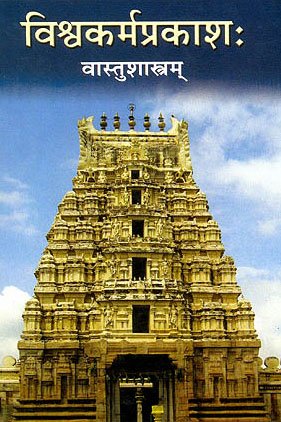
Vastushastra (वास्तुशास्त्र, vāstuśāstra) refers to the ancient Indian science (shastra) of architecture (vastu), dealing with topics such architecture, sculpture, town-building, fort building and various other constructions. Vastu also deals with the philosophy of the architectural relation with the cosmic universe.
In Buddhism
Mahayana (major branch of Buddhism)
Source: De Gruyter: A Buddhist Ritual Manual on AgriculturePratimā (प्रतिमा) refers to “images (of the Buddha)” (suitable for an offering ceremony), according to the Vajratuṇḍasamayakalparāja, an ancient Buddhist ritual manual on agriculture from the 5th-century (or earlier), containing various instructions for the Sangha to provide agriculture-related services to laypeople including rain-making, weather control and crop protection.—Accordingly [as the Bhagavān taught the detailed offering-manual], “[...] Four Nāga kings should be prepared in the middle of the ditch. [...] Flower garlands should be offered. Parched grain and mustard seeds should be scattered there in the middle of the [Nāga] residence. Having scattered flowers, the Four Great Kings should be placed in the four corners. Buddha images (pratimā) with relics, and caityas with relics should be placed in the four directions. [...]”.

Mahayana (महायान, mahāyāna) is a major branch of Buddhism focusing on the path of a Bodhisattva (spiritual aspirants/ enlightened beings). Extant literature is vast and primarely composed in the Sanskrit language. There are many sūtras of which some of the earliest are the various Prajñāpāramitā sūtras.
In Jainism
General definition (in Jainism)
Source: archive.org: Jaina Community: A Social SurveyPratimā (प्रतिमा, “stage”).—The eleven pratimās form part of the rules of conduct for laymen.—The householder’s life has been divided into eleven stages or pratimās. These pratimās form a series of duties and performances, the standard and duration of which rises periodically and which finally culminates in an attitude resembling monkhood. Thus the pratimās rise by degrees and every stage includes all the virtues practised in those preceeding it. The conception of eleven pratimās appears to be the best way of exhibiting the rules of conduct prescribved for the Jaina laymen.
The eleven pratimās are as follows:
- darśana-pratimā,
- vrata-pratimā,
- sāmāyika-pratimā,
- proṣadhopavāsa-pratima,
- sacitta-tyāga-pratimā,
- rātri-bhukta-tyāga-pratimā,
- brahmacarya-pratimā,
- ārambha-tyāga-pratimā,
- parigraha-tyāga-pratimā,
- anumati-tyāga-pratimā,
- uddiṣṭa-tyāga-pratimā.
The householders are advised to ascend these stages step by step. Those who have attained the eleven stages are given special importance by the Digambara Jainas while Śvetāmbaras consider them like ascetics.
Source: archive.org: TrisastisalakapurusacaritraPratimā (प्रतिमा) refers to a form of meditation, as mentioned in chapter 1.1 [ādīśvara-caritra] of Hemacandra’s 11th century Triṣaṣṭiśalākāpuruṣacaritra: an ancient Sanskrit epic poem narrating the history and legends of sixty-three illustrious persons in Jainism.
Accordingly, as the incarnation of Svayambuddha said to the incarnation of king Mahābala:
“[...] At that time omniscience had come to Muni Yugandhara, engaged in pratimā for one night on the peak of the mountain [viz., Ambaratilaka]. Then a great festival called ‘the festival of omniscience’ was being celebrated in his honor by the gods at hand. Then the people living in the towns and villages near the mountain competed with each other to show him honor. When she saw the people, decorated with many ornaments, going there, Nirnāmikā stood in astonishment, as if she were painted in a picture. [...]”.
Note: Pratimā in this sense of meditating in a particular posture is practically the same as kāyotsarga. But they must always stand in pratimā, whereas kāyotsarga may be either standing or sitting.
Source: archive.org: Aspects of Jaina Art and ArchitecturePratimā (प्रतिमा) (Sanskrit; in Prakrit: Padimā) refers to “images” (of human beings), according to the Bṛhatkalpabhāṣya (Vol IV., gāthā 4915): a 6th century commentary on monastic discipline authored by Svetambara Jain exegete Saṅghadāsa.
Source: WikiPedia: JainismPratimā (प्रतिमा, “step”).—In Jainism, pratimā is a step or a stage marking the spiritual rise of a lay person (śravaka). There are eleven such steps called pratimā. After having passed the eleven steps, one is no longer a śrāvaka, but a muni (monk). Rules prescribed for laymen are divided into twelve vrata (vows) and eleven pratimās (steps) and are described in several codes of conduct (śrāvakācāras). The pratimās are mentioned in several ancient texts like Ratnakaraṇḍa-śrāvakācāra (2nd century A.D.)
Source: OpenEdition books: VividhatīrthakalpaḥPratimā (प्रतिमा) refers to a statue position (= kāyotsarga), and represents a Jaina technical term mentioned in the Vividhatīrthakalpa by Jinaprabhasūri (13th century A.D.): an ancient text devoted to various Jaina holy places (tīrthas).

Jainism is an Indian religion of Dharma whose doctrine revolves around harmlessness (ahimsa) towards every living being. The two major branches (Digambara and Svetambara) of Jainism stimulate self-control (or, shramana, ‘self-reliance’) and spiritual development through a path of peace for the soul to progess to the ultimate goal.
India history and geography
Source: Cologne Digital Sanskrit Dictionaries: Indian Epigraphical GlossaryPratimā.—cf. pratimam (SII 2), image of a human being; usually, the image of a deity. Note: pratimā is defined in the “Indian epigraphical glossary” as it can be found on ancient inscriptions commonly written in Sanskrit, Prakrit or Dravidian languages.

The history of India traces the identification of countries, villages, towns and other regions of India, as well as mythology, zoology, royal dynasties, rulers, tribes, local festivities and traditions and regional languages. Ancient India enjoyed religious freedom and encourages the path of Dharma, a concept common to Buddhism, Hinduism, and Jainism.
Languages of India and abroad
Marathi-English dictionary
Source: DDSA: The Molesworth Marathi and English Dictionarypratima (प्रतिम).—a S Like. In comp. as ētat pratima, tat- pratima, sūryapratima, siṃhapratima.
--- OR ---
pratimā (प्रतिमा).—f (S) A resemblance, a figure, an image, a picture. ēkē pratimēcā Of one mould or stamp; of one cast or figure.
Source: DDSA: The Aryabhusan school dictionary, Marathi-Englishpratima (प्रतिम).—a Like.
--- OR ---
pratimā (प्रतिमा).—f A resemblance, a figure, an image.
Marathi is an Indo-European language having over 70 million native speakers people in (predominantly) Maharashtra India. Marathi, like many other Indo-Aryan languages, evolved from early forms of Prakrit, which itself is a subset of Sanskrit, one of the most ancient languages of the world.
Sanskrit dictionary
Source: DDSA: The practical Sanskrit-English dictionaryPratimā (प्रतिमा).—3, 4 Ā. To compare, liken.
--- OR ---
Pratimā (प्रतिमा).—m. Ved. A creator, maker.
-mā 1 An image, a likeness, statue, figure, an idol; पुरः परार्ध्यप्रतिमागृहायाः (puraḥ parārdhyapratimāgṛhāyāḥ) R.16.39.
2) Resemblance, similitude; oft. in comp. in the sense of 'like, similar, or equal to'; देवप्रतिम, अप्रतिम (devapratima, apratima) &c.; गुरोः कुशानुप्रतिमात् (guroḥ kuśānupratimāt) R.2.49; पतत्पतङ्गप्रतिमस्तपोनिधिः (patatpataṅgapratimastaponidhiḥ) Śiśupālavadha 1.12.
3) A reflection, reflected image; मुखमिन्दु- रुज्ज्वलकपोलमतः प्रतिमाच्छलेन सुदृशामविशत् (mukhamindu- rujjvalakapolamataḥ pratimācchalena sudṛśāmaviśat) Śiśupālavadha 9.48,73; R.7. 64;12.1.
4) A measure, extent.
5) The part of an elephant's head between the tusks.
6) A symbol.
Source: Cologne Digital Sanskrit Dictionaries: Edgerton Buddhist Hybrid Sanskrit DictionaryPratima (प्रतिम).—[, in Gaṇḍavyūha 372.16, read apratima-; see s.v. traiyadhvika.]
Source: Cologne Digital Sanskrit Dictionaries: Shabda-Sagara Sanskrit-English DictionaryPratima (प्रतिम).—mfn.
(-maḥ-mā-maṃ) Like, resembling, (In composition) f.
(-mā) 1. A resemblance, a figure, an image, a picture. 2. An idol. 3. The part of an elephant’s head between the tusks. 4. Similarity, Similitude. 5. Measure, extent. E. prati against, mā to measure, aṅ and ṭāp aff.
Source: Cologne Digital Sanskrit Dictionaries: Benfey Sanskrit-English DictionaryPratimā (प्रतिमा).—[prati-mā], f., and pratimāna pratimāna, i. e. prati-mā + ana, n. 1. A resemblance, a figure, [Hitopadeśa] ii. [distich] 149. 2. An idol, [Mānavadharmaśāstra] 9, 285. 3. The part of an elephant’s head between the tusks.
Source: Cologne Digital Sanskrit Dictionaries: Cappeller Sanskrit-English DictionaryPratimā (प्रतिमा).—[masculine] framer, creator; [feminine] measure, image, likeness, picture, idol, symbol, emblem; adj. —° resembling, equal to.
Source: Cologne Digital Sanskrit Dictionaries: Monier-Williams Sanskrit-English Dictionary1) Pratimā (प्रतिमा):—[=prati-√mā] a [Ātmanepada] -mimīte ([Vedic or Veda] [infinitive mood] prati-mai), to imitate, copy, [Ṛg-veda; Vājasaneyi-saṃhitā; Kauśika-sūtra]
2) [v.s. ...] b m. a creator, maker, framer, [Atharva-veda; Vājasaneyi-saṃhitā]
3) [v.s. ...] f. an image, likeness, symbol, [Ṛg-veda] etc. etc.
4) [v.s. ...] a picture, statue, figure, idol, [Manu-smṛti; Harivaṃśa; Raghuvaṃśa] ([Indian Wisdom, by Sir M. Monier-Williams 218, 1; 241])
5) [v.s. ...] reflection (in [compound] after a word meaning ‘moon’ cf. below)
6) [v.s. ...] measure, extent (cf. below)
7) [v.s. ...] Name of a metre, [Ṛgveda-prātiśākhya]
8) [v.s. ...] the part of an elephant’s head between the tusks (also ma m.), [cf. Lexicographers, esp. such as amarasiṃha, halāyudha, hemacandra, etc.] (ifc. like, similar, resembling, equal to, [Taittirīya-brāhmaṇa; Mahābhārata] etc.; having the measure of, as long or wide etc. as e.g. tri-nalva-pr, 3 Nalvas long, [Harivaṃśa]; ma-tā f. ma-tva n. reflection, image, shadow, [Horace H. Wilson])
Source: Cologne Digital Sanskrit Dictionaries: Yates Sanskrit-English DictionaryPratima (प्रतिम):—[prati-ma] (maḥ-mā-maṃ) a. Like. f. Image.
Source: DDSA: Paia-sadda-mahannavo; a comprehensive Prakrit Hindi dictionary (S)Pratima (प्रतिम) in the Sanskrit language is related to the Prakrit words: Paḍima, Paḍimā, Paḍimi, Paḍimiṇa, Paḍihā.
[Sanskrit to German]
Sanskrit, also spelled संस्कृतम् (saṃskṛtam), is an ancient language of India commonly seen as the grandmother of the Indo-European language family (even English!). Closely allied with Prakrit and Pali, Sanskrit is more exhaustive in both grammar and terms and has the most extensive collection of literature in the world, greatly surpassing its sister-languages Greek and Latin.
Hindi dictionary
Source: DDSA: A practical Hindi-English dictionaryPratimā (प्रतिमा):—(nf) an image, icon, a statue; effigy; -[pūjā] idolatory; iconolatory; ~[vijñāna] iconoscope; iconography; -[bhaṃjana] iconoclasm; -[bhaṃjaka] an iconoclast; iconoclastic.
...
Kannada-English dictionary
Source: Alar: Kannada-English corpusPratima (ಪ್ರತಿಮ):—[adjective] of the same quantity, size, number, value, degree, intensity, quality, etc.; equal.
--- OR ---
Pratima (ಪ್ರತಿಮ):—[noun] any thing that is or person who is same or equal (to); an equal.
Kannada is a Dravidian language (as opposed to the Indo-European language family) mainly spoken in the southwestern region of India.
See also (Relevant definitions)
Starts with (+76): Pratima-vijnana, Pratimabada, Pratimacandra, Pratimachandra, Pratimadana, Pratimadanavidhi, Pratimadhyama, Pratimadravyadivacana, Pratimagata, Pratimageha, Pratimagriha, Pratimahanasa, Pratimahavyahriti, Pratimahisha, Pratimai, Pratimakarman, Pratimala, Pratimalakshana, Pratimalla, Pratimallata.
Ends with (+29): Abrahmavarjanapratima, Anumatityagapratima, Apratima, Arambhatyagapratima, Ashtavidhapratima, Atankapratima, Ayahpratima, Balarkapratima, Brahmacaryapratima, Brahmacharyapratima, Buddhapratima, Daivatapratima, Darshanapratima, Devapratima, Devatapratima, Hemapratima, Indrapratima, Kayotsargapratima, Laghupratima, Lohapratima.
Full-text (+330): Apratima, Padima, Brahmacarya, Parigrahatyaga, Vrata, Pratimata, Uddishtatyagapratima, Darshanapratima, Sacittatyaga, Poshadhapratima, Anumatityaga, Arambhatyagapratima, Samayika, Kayotsargapratima, Vratapratima, Sacittatyagapratima, Uddishtatyaga, Proshadha, Pratimagata, Padiha.
Relevant text
Search found 56 books and stories containing Pratima, Prati-ma, Prati-mā, Pratimā, Pratimaa; (plurals include: Pratimas, mas, mās, Pratimās, Pratimaas). You can also click to the full overview containing English textual excerpts. Below are direct links for the most relevant articles:
Middle Chola Temples (by S. R. Balasubrahmanyam)
4. Icons set up By Rajaraja I’s Officers and others < [Tanjavur/Thanjavur (Rajarajesvaram temple)]
Garga Samhita (English) (by Danavir Goswami)
Verse 6.21.32 < [Chapter 21 - In the Description of the Third Fort, the Glories of Piṇḍāraka-tīrtha]
Verse 8.13.122 < [Chapter 13 - A Thousand Names of Lord Balarāma]
Brihad Bhagavatamrita (commentary) (by Śrī Śrīmad Bhaktivedānta Nārāyana Gosvāmī Mahārāja)
Verse 2.4.213 < [Chapter 4 - Vaikuṇṭha (the spiritual world)]
Verse 2.4.207 < [Chapter 4 - Vaikuṇṭha (the spiritual world)]
Verse 2.4.202 < [Chapter 4 - Vaikuṇṭha (the spiritual world)]
Sahitya-kaumudi by Baladeva Vidyabhushana (by Gaurapada Dāsa)
Text 9.21 < [Chapter 9 - Ornaments of Sound]
Text 10.1 [Upamā] < [Chapter 10 - Ornaments of Meaning]
Rig Veda (translation and commentary) (by H. H. Wilson)
Bhagavati-sutra (Viyaha-pannatti) (by K. C. Lalwani)
Part 3 - Dialogue with Skandaka < [Chapter 1]
Part 5 - Birth of Camarendra < [Chapter 2]
Part 3 - Pain from and exhaustion of karma < [Chapter 1]
Related products
